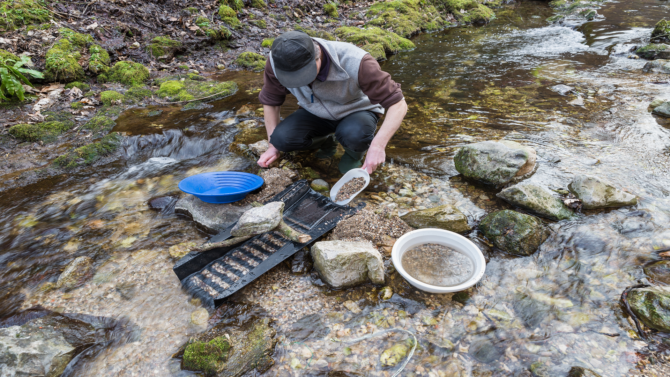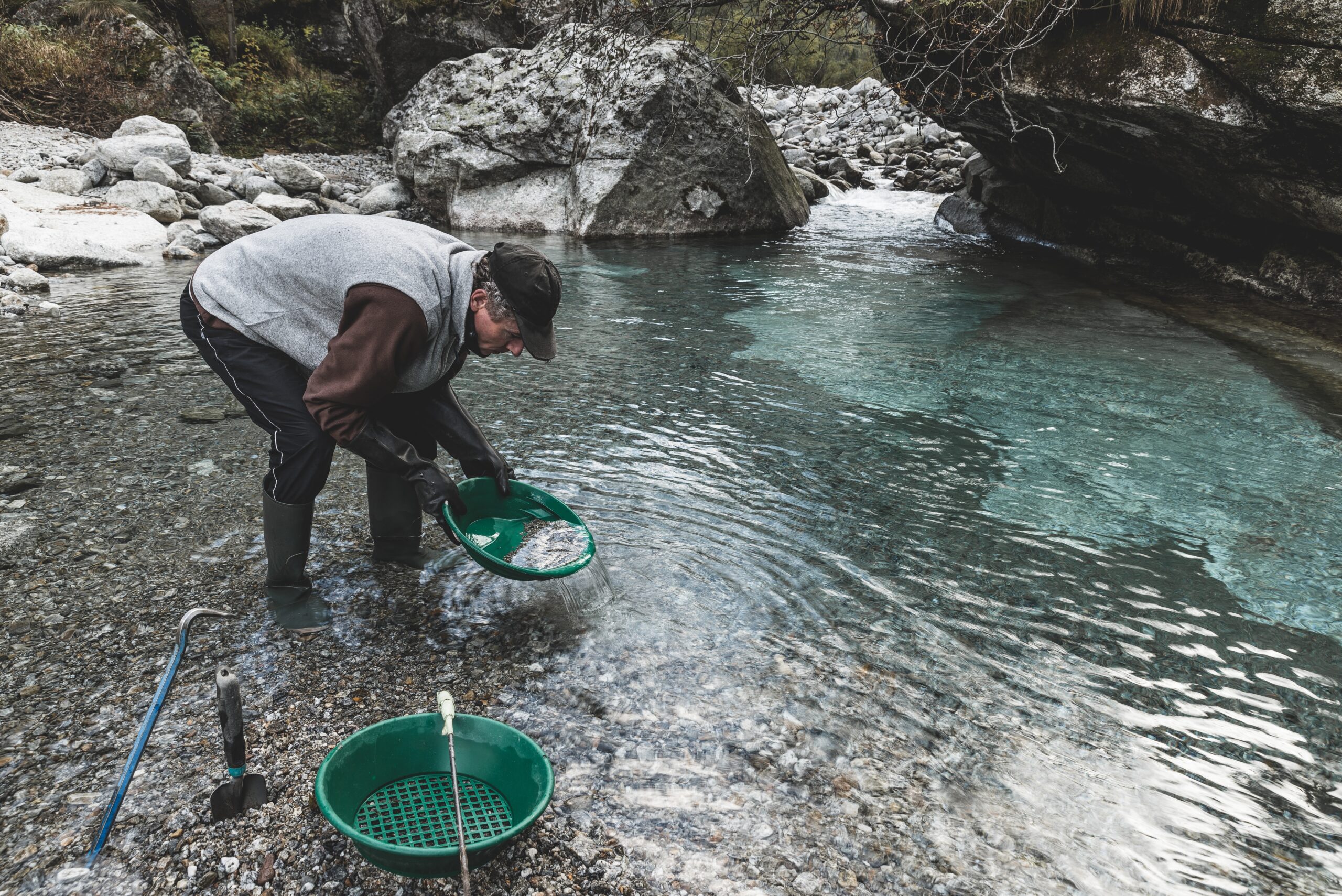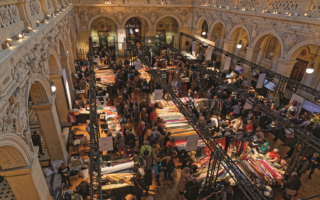Gold mining in France

Hidden along some riverbanks in France are surprisingly large deposits of alluvial gold. Jon Bryant joins the weekenders trying to unearth a nugget…
The Romans didn’t call France Gallia Aurifera (Golden Gaul) for nothing. Two millennia ago, ten tons of gold was extracted from the country each year but since the end of the 19th century, no one has bothered much about French gold. It wasn’t until the publication of Jean- Claude Le Faucheur’s book. Chercheur d’or en France in 1976, that a new generation of prospectors was galvanized and sales of trowels, sieves and magnifying glasses have soared ever since.
Setting off on my first gold run I begin to get excited. What if I find so much gold I can’t lift the pan? What if my dog unearths a nugger the size of a croissant?
Sadly within a few moments of talking to gold panner exceptionelle Véronique Vilain, my dream is shattered. She laughs and tells me no one gets rich from panning gold and after a day of back-breaking sieving and sifting, I’ll be lucky to find enough to repair a mouse’s filling. However, she says, I will definitely find some everyone does.
Biggest Gold Rush
Vilain ran the gold-hunting company Oreval and organised gold panning trips in the River Gardon north- west of Nimes. She has been looking for gold for more than 20 years and takes her holidays in places like Coloma in California -scene of the world’s biggest gold rush in 1848 so she can carry on searching. She’s currently taking a break but reckons she’ll be back next year. Her 4×4 is still crammed with a selection of trays, sieves, trowels and galoshes.
Most of the people who go on her trips are over 35 and enjoy spending the day crouched over a pan in the river, knowing that it’s the process and the hope rather than the prizes that make gold panning enjoyable. “I always start off by crushing their illusions,” she says. “They soon realise they are not going to be finding a nugget the size of a golf ball, but will have to be satisfied with dust and flecks and the odd grain. Families come too and children really enjoy doing it for a few hours but mainly I’m helping adults to fulfil their childhood fantasies.”
By the end of the day, exhausted panners will be able to take away enough gold to cover half a grain of rice but there will be a good few whose pans reveal something almost lentil-sized. The groups who go with her clearly love it and continue to send her emails describing their latest findings. “In the summer we are here until eight in the evening and no one wants to leave. When I have a big group (sometimes over 20), it turns into a bit of a competition.”

© Shutterstock
To begin all you need is a pan that looks like an upturned Chinese hat with ridges on one side (une batée), a trowel to dig into the earth and perhaps a teaspoon to reach into the tiny gaps between rocks. After that, it’s just a case of understanding how the river flows and where the best sites are. Vilain explains that France is particularly well-endowed with gold because it has so many quartz-filled mountains and rivers running away from them. The gold is contained within the quartz but gradual erosion ‘releases the gold’ and the further away from the mountain you are, the more gold will be released, carried off downstream and deposited alongside the river bed or wherever the water ‘slows’.
“The key is in the natural barriers, anything from a section of ridged bedrock to a meander in the river, plant roots, mossy banks and even a simple eddy will mean the water changes course and may leave a few fragments of the precious metal. The water and landscape are changing all the time, particularly in the Gard which is prone to flooding, and gold is constantly flushed down from the mountains. You have to look for a feature in the river that operates as a natural brake.”

© Shutterstock
Buried Treasure
We meet at Vilain’s favourite gold-panning location beside a campsite in the medieval village of Cardet. There are other reasons to come to Cardet but most people come for the gold. “You can pan all year round but the real pleasure is to squat in the cool river in the scorching summer. If you get tired or too hot, you can lie back in the water,” she says.
Vilain shows me how to dig up earth beside a buried tree trunk alongside the river and gently tip and twist the pan on the river’s surface, letting the water run through the grains and ‘clean’ the sand and stones until a few glistering fragments appeared on the top side of the batée.
The smallest fleck is called simply a couleur and is only just visible. Growing larger in size, you can definitely see a point, then there’s a paille, a paillette, a grosse paillette, an aile de mouche (fly’s wing), a grain and finally a pépite. Putting this in context, a pépite in the Gardon d’Anduze tributary is about the size of a child’s fingernail. But however small the dot, and believe me, it can be pretty small, it’s gold! What’s more, it’s probably the purest gold you’ll ever touch at a tip under 24 carat.

© Shutterstock
Vilain went gold panning with her former husband on their first date and has been doing it ever since. She used to live in Lyon but moved down to the Gardon to be near her gold. She lived off it – but mainly from the trips, not from finding it. Her skill is in ‘reading the river. She says there are now quite a few people like her in France who run gold-hunting courses.
Gold is found mainly in the rivers in the south of France. Apart from the Gardon, there’s the Cèze, Gagnière, the Salat and L’Ariège. Other rivers in the Limousin, Brittany and the Pyrénées have lesser reserves and it’s also possible to find gold in the Auvergne and Jura. Altogether, about 100 rivers in France have some gold flowing through them.
Finger Tingling
Gold hunting must be declared by a formal letter to the departmental prefecture detailing where and when you will be looking and what tools you are using. Mechanised equipment is banned for all amateurs. Obviously if you do a course with a professional company, all this is taken care of and you can go home with your booty.
I can feel a tingling in my fingers and arms. It’s not the gold sensation yet, it’s just the effort of lapping water in and out of the pan and gently twisting it round. Fill the pan, soak, twist, lap, lap, twist, empty, twist, submerge, spin, lap – it’s exhausting but what keeps you going is the knowledge that when you’re done and there’s barely a sediment left in the pan, some of it is going to be shining quite brightly.
“We have a lot of Germans and Dutch and people from Luxembourg seem to like prospecting but so far not many British,” says Vilain. “People come with a lot of false ideas. They think that gold is rare — it’s not – that it’s expensive, mostly turned into jewellery and that they’ll become rich. None of it is true.”
Most gold is used by the aeronautical and electronics industries – satellites are covered in gold, French health cards have gold leaf on them and less than a fifth of the precious metal ever ends up as jewellery. She keeps little test tubes full of bullion dust and fragments and that is how she likes it. For Vilain, gold is how you find it. She appears quite sentimental about it and doesn’t believe in melting things down and changing them. She’s a geologist at heart. Most of the gold hunters feel the same.
Catherine Massat (Catou to her friends or fellow panners) has also been hunting for gold for more than 20 years and was shown how to do it by Jean-Claude Le Faucheur himself in the early 1980s. She now runs half-day courses in gold panning in the River Sarlat at Saint-Girons in the Ariège from June until October. “I love the interaction with people and it’s such an enjoyable thing to do,” she says. She makes jewellery out of what she finds, gold dust carefully slid into a drop of blown glass and then sealed.
You can even win a gold medal. Last year they held the 12th European Gold Panning Championships in Cardet. Competitions used to be held using artificial basins to see who could extract the most gold but now tend to be more ‘natural’ and competitors line up along a riverbank. There’s more luck involved but then gold hunting is all about luck.
Last year’s European champion was Frenchman Gilbert Chomat who managed to find a grand total of 0.358 grams of gold. Overall, 58 individuals took part in the championships, equating to 680 hours of gold panning with just over 9 grams of alluvial gold found the same weight as a €2 coin. Anyone can take part in the championships as long as you keep at least one metre away from your neighbour. It’s certainly more fun than fishing, less dangerous than water skiing and you’re not going to get rich playing boules, so you might as well do something more profitable with your arms.
Looking for more travel inspiration?
France Today is the world’s leading travel and lifestyle title about France, with a magazine and website that appeal to Francophiles around the globe.
Lead photo credit : © Shutterstock
Share to: Facebook Twitter LinkedIn Email
More in Gold, Nouvelle Aquitaine, Travel


